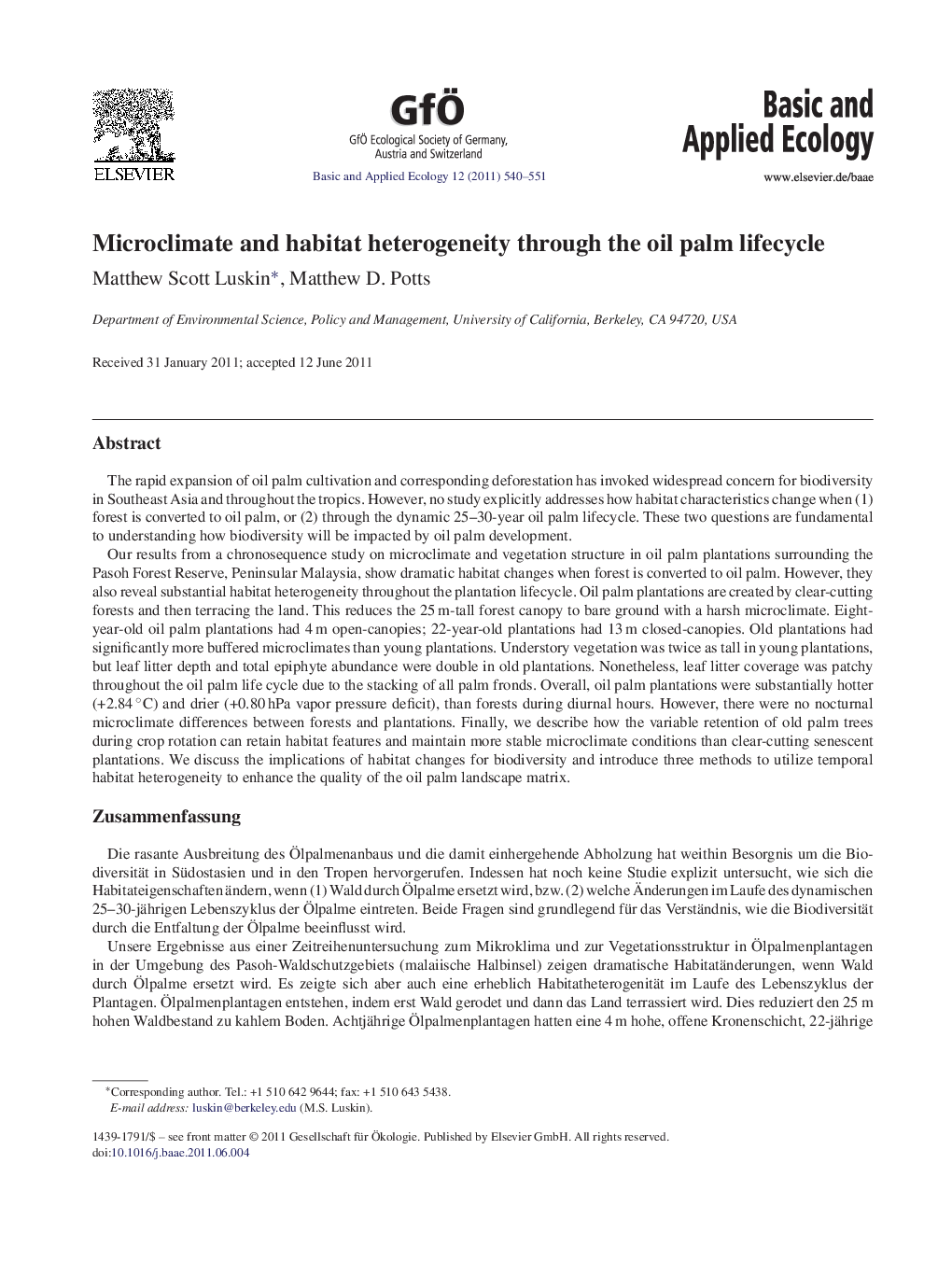| کد مقاله | کد نشریه | سال انتشار | مقاله انگلیسی | نسخه تمام متن |
|---|---|---|---|---|
| 4384444 | 1304414 | 2011 | 12 صفحه PDF | دانلود رایگان |

The rapid expansion of oil palm cultivation and corresponding deforestation has invoked widespread concern for biodiversity in Southeast Asia and throughout the tropics. However, no study explicitly addresses how habitat characteristics change when (1) forest is converted to oil palm, or (2) through the dynamic 25–30-year oil palm lifecycle. These two questions are fundamental to understanding how biodiversity will be impacted by oil palm development.Our results from a chronosequence study on microclimate and vegetation structure in oil palm plantations surrounding the Pasoh Forest Reserve, Peninsular Malaysia, show dramatic habitat changes when forest is converted to oil palm. However, they also reveal substantial habitat heterogeneity throughout the plantation lifecycle. Oil palm plantations are created by clear-cutting forests and then terracing the land. This reduces the 25 m-tall forest canopy to bare ground with a harsh microclimate. Eight-year-old oil palm plantations had 4 m open-canopies; 22-year-old plantations had 13 m closed-canopies. Old plantations had significantly more buffered microclimates than young plantations. Understory vegetation was twice as tall in young plantations, but leaf litter depth and total epiphyte abundance were double in old plantations. Nonetheless, leaf litter coverage was patchy throughout the oil palm life cycle due to the stacking of all palm fronds. Overall, oil palm plantations were substantially hotter (+2.84 °C) and drier (+0.80 hPa vapor pressure deficit), than forests during diurnal hours. However, there were no nocturnal microclimate differences between forests and plantations. Finally, we describe how the variable retention of old palm trees during crop rotation can retain habitat features and maintain more stable microclimate conditions than clear-cutting senescent plantations. We discuss the implications of habitat changes for biodiversity and introduce three methods to utilize temporal habitat heterogeneity to enhance the quality of the oil palm landscape matrix.
ZusammenfassungDie rasante Ausbreitung des Ölpalmenanbaus und die damit einhergehende Abholzung hat weithin Besorgnis um die Biodiversität in Südostasien und in den Tropen hervorgerufen. Indessen hat noch keine Studie explizit untersucht, wie sich die Habitateigenschaften ändern, wenn (1) Wald durch Ölpalme ersetzt wird, bzw. (2) welche Änderungen im Laufe des dynamischen 25–30-jährigen Lebenszyklus der Ölpalme eintreten. Beide Fragen sind grundlegend für das Verständnis, wie die Biodiversität durch die Entfaltung der Ölpalme beeinflusst wird.Unsere Ergebnisse aus einer Zeitreihenuntersuchung zum Mikroklima und zur Vegetationsstruktur in Ölpalmenplantagen in der Umgebung des Pasoh-Waldschutzgebiets (malaiische Halbinsel) zeigen dramatische Habitatänderungen, wenn Wald durch Ölpalme ersetzt wird. Es zeigte sich aber auch eine erheblich Habitatheterogenität im Laufe des Lebenszyklus der Plantagen. Ölpalmenplantagen entstehen, indem erst Wald gerodet und dann das Land terrassiert wird. Dies reduziert den 25 m hohen Waldbestand zu kahlem Boden. Achtjährige Ölpalmenplantagen hatten eine 4 m hohe, offene Kronenschicht, 22-jährige Plantagen wiesen 13 m hohe, geschlossene Kronenschichten auf. In alten Plantagen war das Mikroklima deutlich stärker gepuffert als in jungen Plantagen. Der Unterwuchs war in jungen Plantagen zweimal höher, die Streuschichtdicke und die Epiphytensiedlungsdichte waren in alten Plantagen verdoppelt. Nichtsdestotrotz war die Bodenbedeckung durch Blattstreu in allen Plantagenstadien fleckenhaft, weil die Palmwedel gestapelt werden. Insgesamt waren die Plantagen während des Tages erheblich wärmer (+2.84 °C) und trockener (+0.80 hPa Wasserdampfsättingungsdefizit) als die Wälder. Allerdings gab es keine Unterschiede zwischen Plantagen und Wald hinsichtlich des nächtlichen Mikroklimas.
Journal: Basic and Applied Ecology - Volume 12, Issue 6, September 2011, Pages 540–551